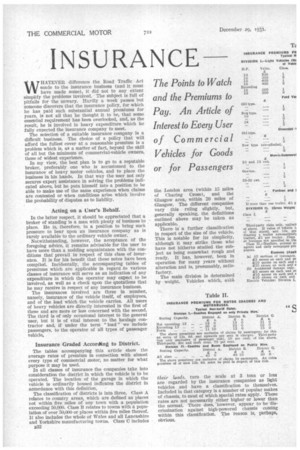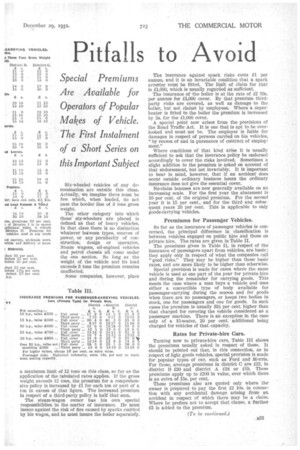INSURANCE Pitfalls to Avoid
Page 46

Page 47

If you've noticed an error in this article please click here to report it so we can fix it.
WHATE VER difference the Road Traffic Act made to the insurance business (and it must have made some), it did not to any extent simplify the problems involved. The subject is full of pitfalls for the unwary. Hardly a week passes but someone discovers that the insurance policy, for which he has paid such substantial annual premiums for years, is not all that he thought it to be, that some essential requirement has been overlooked, and, as the result, he is involved in heavy expenditure which he fully expected the insurance company to meet.
The selection of a suitable insurance company is a difficult business. The choice of a policy that will afford the fullest cover at a reasonable premium is a problem which is, as a matter of fact, beyond the skill of all but the minimum of commercial-vehicle owners, those of widest experience.
In my view, the best plan is to go to a reputable broker, preferably one who is accustomed to the insurance of heavy motor vehicles, and to place the business in his hands. In that way the user not only secures expert assistance in solving the problems indicated above, but he puts himself into a position to be able to make use of the same experience when claims are contested or when conditions arise which involve the probability of disputes as to liability.
Acting on a User's Behalf.
In the latter respect, it should be appreciated that a broker of standing is a man with plenty of business to place. He is, therefore, in a position to bringsuch pressure to bear upon an insurance company as is rarely available to the ordinary vehicle owner.
Notwithstanding, however, the acceptance of the foregoing advice, it remains advisable for the user to have more than a nodding acquaintance with the conditions that prevail in respect of this class of insurance. It is for his benefit that these notes have been compiled. Incidentally, the accompanying tables of premiums which are applicable in regard .to various classes of insurance will serve as an indication of any expenditure in which the operator may expect to be involved, as well as a check upon the quotations that he may receive in respect of any insurance business.
The insurances involved are three in number, namely, insurance of the vehicle itself, of employees, and of the Load which the vehicle carries. All users of heavy vehicles are directly interested in the first of these and are more or less concerned with the second. The third is of only occasional interest to the general user, but it is of vital interest to the haulage contractor and, if under the term " load " we include passengers, to the operator of all types of passenger vehicle,
Insurance Graded According to District.
The tables accompanying this article show the average rates of premium in connection with almost every type of commercial motor, no matter for what purpose it may be used.
In all classes of insurance the companies take into consideration the district in which the vehicle is to he operated. The location of the garage in which the vehicle is ordinarily housed indicates the district in accordance with this definition
The classification of districts is into three. Class A relates to country area; which are defined as places not within five miles of any town with a population exceeding 50,000. Class B relates to towns with fl population of over 50,000 or places within five miles thereof. It also includes the whole of Wales and all Lancashire and Yorkshire manufacturing towns. Class C includes
B32
the London area (within 15 miles of Charing Cross), and the Glasgow area, within 20 miles of Glasgow. The different companies vary this ruling slightly, but, generally speaking, the definitions outlined above may be taken as applicable.
There. is a further classification in respect of the size of the vehicle. This is notable for its simplicity, although it may strike those who have not hitherto studied the subject as being somewhat rough and ready. It has, however, been in operation for many years without alteration and is, presumably, satisfactory.
The main division is determined by weight. Vehicles which, with their loads, turn the scale at 3 tons or less are regarded by the insurance companies as light vehicles and have a classification to themselves. Included in that category is a number of popular makes of chassis, to most of which special rates apply. These rates are not necessarily either higher or lower than the normal. There does, 'however, appear to be discrimination against high-powered chassis coming within this classification. The reason is, perhaps, obvious.
Six-wheeled vehicles of any denomination are outside this class. Actually, we imagine there must be few which, when loaded, do not pass the border line of 3 tons gross weight.
The other category into which these' six-wheelers are placed is defined, as that of heavy vehicles. In that class there is no distinction whatever •between types, sources of power, or any peculiarity of construction, design or operation. Steam wagons, oil-engined vehicles and petrol chassis all come under the one section. So long as the weight of the vehicle and its load exceeds 3 tons the premium remains unaffected. • Some companies, however, place a maximum limit of 12 tons on this class, so far as the application of the tabulated rates applies. If the gross weight exceeds 12 tons, the premium for a comprehensive policy is increased by £1 for each ton or part of a ton in excess of that figure. The increased premium in respect of a third-party policy is half that sum.
The steam-wagon owner has his own special responsibilities in the matter of insurance. Ile must insure against the risk of fire caused by sparks emitted by his wagon, and he must insure the boiler separately. The insurance against spark risks costs El per annum, and it is an invariable condition that a spark arrester must be fitted. The limit of claim for that is £1,000, which is usually regarded as sufficient.
The insurance of the boiler is at the rate of £2 10s. per annum for £1,000 cover. By that premium thirdparty risks are covered, as well as damage to the boiler, but not claims by employees. Where a superheater is fitted to the boiler the premium is increased by 5s. for the £1,000 cover.
A special point now arises from the provisions of the Road Traffic Act. It is one that is apt to be overlooked and must not be. The employer is liable for damages in respect of persons carried on his vehicles, "by reason of and in pursuance of contract of employment."
Where conditions of that kind arise it is usually sufficient to ask that the insurance policy be endorsed accordingly to cover the risks involved. Sometimes a slight addition to the premium is asked on account of that endorsement, but not invariably. It is important to bear in mind, however, that if an accident does occur outside ordinary business hours the ordinary insurance does not give the essential cover.
No-claim bonuses are now generally available on an increasing scale. For the first year the abatement is 10 per cent, of the original premium. For the second year it is 15 per cent., and for the third and subse quent years 20 per cent. This is applicable to only goods-carrying vehicles.
Premiums for Passenger Vehicles.
So far as the insurance of passenger vehicles is concerned, the principal difference in classification is between vehicles engaged on public hire and those on private hire. The rates are given in Table II. The premiums given in Table II, in respect of the insurance of passengers apart from vehicles, are basic ; they apply only in respect of what the companies call "good risks." They may be higher than those basic rates, and are more likely to be higher than otherwise.
Special provision is made for cases where the same vehicle is used at one part of the year for private hire and during the remainder for carrying goods. This meets the case where a man buys a vehicle and uses either a convertible type of body available for passenger-carrying during the season and for goods when there are no passengers, or keeps two bodies in stock, one for passengers and one for goods. In such cases the premium is usually 33iper cent, higher than that charged for covering the vehicle considered as a passenger machine. There is an exception in the case only of a 15-seater, 20 per cent, additional being charged for vehicles of that capacity.
Rates for Private-hire Cars.
Turning now to private-hire cars, Table III shows the premiums usually asked in respect of these. It should be pointed out that, in this connection, as in respect of light goods vehicles, special provision is made for popular types of car, such as Ford and Morris. For those, average premiums in district C are £22, in district B £20 and district A EIS or £19. These premiums apply up to £200 in value, over which there is an extra of 15s. per cent.
These premiums also are quoted only where the owner is prepared to pay the first 12 10s. in connection with any accidental damage arising from an accident in respect of which there may be a claim. Where he prefers not to accept that clause, a further £3 is added to the premium.




























































































